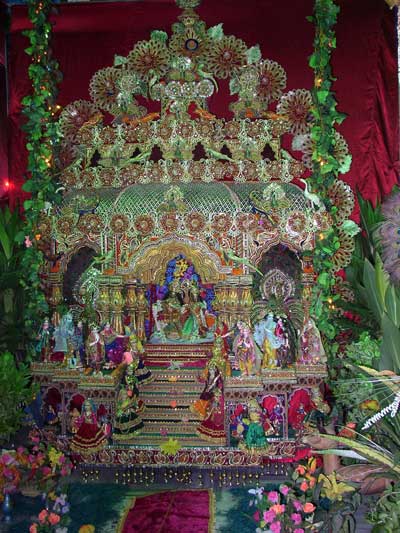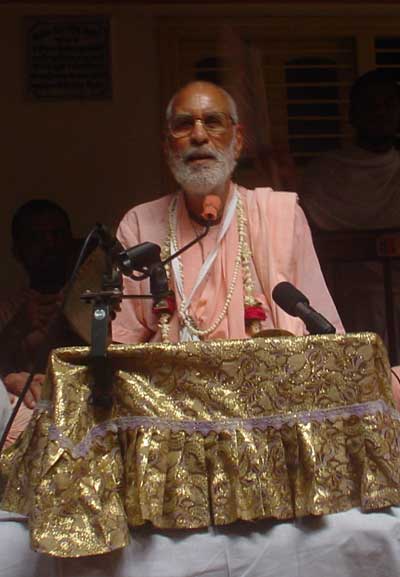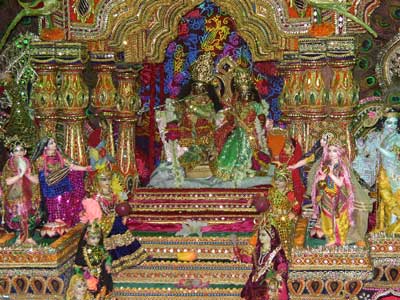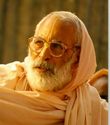


[Every year there is a five day festival all over Vrndavana called Jhulana-yatra, at which time the vijaya-vigraha (small) Deities of Sri Sri Radha and Krsna are swung by hundreds of thousands of Vrajabasis and others, in their various temples or homes, on a beautiful swing attached to long ropes. Srila Narayana Maharaja yearly leads this festival at Sri Kesavaji Gaudiya Matha and Sri Rupa Sanatana Gaudiya Matha, at which time he gives a short talk about the significance of this festival. This year, 2009, Sri Sri Radha-Krsna's Jhulan ceremony is August 1st. The following is a translation of both his Hindi talks, given on August 8, 2003:]
In the month of Sravana (the rainy season), the clouds in the sky begin to make a thundering sound and extremely fine mist-like rain drizzles everywhere. The atmosphere is very beautiful and pleasant after the heat of the summer months, for at that time all the forests of Vrndavana begin to bloom. Many types of flowers on both sides of the Yamuna, such as beli, cameli, jui, and madhavi begin to bloom. The bumblebees look here and there and chant, "Radhe Radhe" and the cuckoos also call out, “Radhe Radhe.”
The peacocks and peahens all call out “Keka keka.” Ke means: “Which male person has the ability to do a very wonderful thing? Srimati Radhika’s maan (Her sulky mood of transcendental loving jealous anger), as well as Her shyness and patience, are like a very tall and immovable mountain. Which male person, ‘Ke,’ can crush that mountain into powder so that there is nothing left? This person is Sri Krsna.” Ka means: “Which female person can do a very wonderful thing? There is a powerful, mad elephant named Sri Krsna whom no one can control. One person, however, by the goad of Her maan, can catch that elephant, bring Him under Her control, and then bind Him in the shackle of Her prema. Who is that? It is Srimati Radhika.” In this way the peacocks and peahens glorify Srimati Radharani and Lord Krsna.
At the time of Sravana, everything becomes green. The summer was dry, but now the rain has come and everything has come to life again. All the young brides are taken at this time from their mother-in-laws’ homes by their brothers, and they return to their fathers’ home.
Srimati Radhika was still at Her in-laws’ home in Yavat, however, because Her brother, Sridama, had not come. Much time passed and finally he arrived there on the full moon day, with some clothing and ornaments to pacify Srimati Radhika’s mother-in-law, Jatila.
Seeing Her brother Srimati Radhika wept, “O My dear brother, why have you come so late? Only a few days remain of this Sravana month. Why did you come late? Did you forget Me?”
Srimati Radhika then very happily left Yavat and went to Varsana, Vrsabhanupura, with Her brother; and there She met together with all of Her sakhis, Her intimate friends, as they had also returned to their maternal homes at that time. It was a very beautiful meeting and reunion in the place of their childhood play.
The sakhis made a jhulana (swing) for Her. They always make the swing on a kadamba tree and not on a tamal tree. The significance of a kadamba tree is that it carries the complexion of Srimati Radhika and the tamal tree has a complexion of Sri Krsna. The tamal tree is not very powerful, but the kadamba tree is very strong and beautiful. This signifies the superiority of Srimati Radhika – She can control Lord Krsna by Her love.
jhula jhule radha damodara vrndavana menWe sing this kirtana at the time of swinging Sri Sri Radha and Krsna. It describes how Lord Krsna has come and is waiting at the swing with folded palms for His beloved to come. Srimati Radhika is in maan, and Her sakhis try to persuade Her to come by saying, "Please give up your sulky mood and come at once to your beloved Krsna. He is waiting for You."
kaisi cchayi hariyali ali kunjan men["Radha-Damodara are swinging on the swing in Vrndavana. O friend, how very green the kunja is!"
(Jhula Jhule Radha Damodara, verse 1)]
In this way we are observing Jhulana-yatra and remembering the sweet pastimes of Sri Sri Radha and Krsna.

[When Srila Narayana Maharaja’s discourse was completed, the over 200 devotees at Sri Rupa Sanatana Mandira then accompanied him on the five minute walk to Sri Gopinatha Gaudiya Matha, where they all performed the swing ceremony for Sri Sri Radha Gopinatha and sang the same kirtana. The assembled devotees then sat in the temple courtyard to hear Srila Maharaja speak once again:]
Tomorrow is the disappearance day of Srila Rupa Gosvami. Even though there are so many great acaryas, Srila Rupa Gosvami has been attributed with the honor of being that person who has established the mano-‘bhistam, the innermost heart’s desire, of Sri Krsna in the form of Caitanya Mahaprabhu. When Sriman Mahaprabhu came to the village of Ramakeli-grama, He met with Srila Rupa Gosvami and Srila Sanatana Gosvami and told them, "Leave your homes and be with Me." After a short time they left their homes, and Sri Caitanya Mahaprabhu came from Vrndavana and met with Srila Rupa Gosvamipada at Prayag, the confluence of the rivers Yamuna and Ganga. Sri Caitanya Mahaprabhu told him:
parapara-sunya gabhira bhakti-rasa-sindhuLord Caitanya gave one drop of the ocean of rasa to Srila Rupa Gosvami, and that one drop was sufficient to inundate millions upon millions of universes. Later, He met with Srila Sanatana Gosvami in Varanasi.
tomaya cakhaite tara kahi eka bindu["The ocean of the transcendental mellows of devotional service is so large that no one can estimate its length and breadth. However, just to help you taste it, I am describing one drop.
(Sri Caitanya-caritamrta Madhya-lila 19.137)”]
After some time, Srila Rupa Gosvami and Srila Sanatana Gosvami came here to Vrndavana and began to perform their bhajana, their hearing, chanting, and remembering about Krsna. Rupa Gosvami thought, "In order to fulfill the innermost heart’s desire of Sri Caitanya Mahaprabhu, I will write a drama. In this drama I will explain the beauty of the meeting pastimes of Srimati Radhika and Sri Krsna in Vrndavana, and also Their separation pastimes, when Lord Krsna leaves Vrndavana and goes to Mathura and Dvaraka. I will explain how, by their expansions, Srimati Radhika and all the sakhis somehow or other (by the medium of their expansions) went to Dvaraka and became Lord Krsna’s 16,108 queens."
He intended to write about this, but while he was traveling towards Jagannatha Puri he came to the village of Satyabhama-pura. There, Srimati Satyabhama-devi, Lord Krsna’s chief queen, appeared to him in a dream and told him, "Please don’t make only one drama. Please divide it into two parts."
Then, when Srila Rupa Gosvami finally arrived at Jagannatha Puri and met with Sri Caitanya Mahaprabhu, the Lord confirmed what he had heard from Srimati Satyabhama in his dream. Sriman Mahaprabhu told him, “Don’t take Lord Krsna out of Vrndavana.”
krsno 'nyo yadu-sambhuto yah purnah so 'sty atah parah“Krsna never leaves Vrndavana. He never even sets one foot outside of Vrndavana.”
vrndavanam parityajya sa kvacin naiva gacchati["The Krsna known as Yadu-kumara is Vasudeva Krsna. He is different from the Krsna who is the son of Nanda Maharaja. Yadu-kumara Krsna manifests His pastimes in the cities of Mathura and Dvaraka, but Krsna the son of Nanda Maharaja never at any time leaves Vrndavana."
(Caitanya-caritamrta Antya-lila 1.67)]
Srila Rupa Gosvami then divided his drama into two parts. The first part is called Vidagdha-madhava, Krsna’s pastimes in Vrndavana; and in the second part, called Lalita-madhava, He goes to Dvaraka and all the gopis of Vrndavana were reunited with Him in the form of the queens of Dvaraka.
Why did Srila Rupa Gosvami do this? This is a very deep siddhanta, conclusive philosophical truth. Srila Kavi Karnapura, a very great devotee, has composed Sri Ananda Vrndavana Campu. In this book he described the pastimes of Lord Krsna from His birth up to rasa-lila and the Divine Couple’s swing pastimes, and he stopped there. He didn't go any further than this. He didn't describe about Krsna going to Mathura or Dvaraka, because this separation mood is very difficult to tolerate for the pure devotees. He was thinking, "My Mistress Radhika cannot tolerate this separation, so I will not write about it."
Srila Rupa Gosvami, however, has written about the moods of both meeting and separation – because this separation mood is a very deep transcendental ecstatic feeling. At the time of meeting, though Radharani and Krsna are together, something may be forgotten or lost in the heart. On the other hand, at the time of separation, there is complete meeting in new and fresh ways in the heart; and not only inside, but sometimes externally there are sphurtis, temporary visions in which the loved one is actually present.
Knowing all these very deep transcendental established truths, and wanting to establish the desire of Sri Caitanya Mahaprabhu within the world, Srila Rupa Gosvami also glorified the mood of separation. Although this mood is very high and has many transcendental features that will not come at the time of meeting, still, it is not our goal of life.
No Gaudiya Vaisnavas want Sri Sri Radha and Krsna to be eternally separated. What kind of person would want this? No Vrajavasi would want it. However, there is a place for this separation mood, and Srila Rupa Gosvami has explained this in his book, Ujjvala Nilamani: "Na vina vipralambha sambhoga pusti masnute. Without the mood of separation, the mood of meeting will not be nourished and come to increasingly higher stages. The pastimes of separation are very important because they play the role of nourishing the sweetness of meeting."
When Srila Rupa Gosvami was in Puri with Sri Caitanya Mahaprabhu, the Lord was dancing at the Ratha-yatra festival and uttering a verse from a book of mundane poetry called sahitya-darpana:
yah kaumara-harah sa eva hi varas ta eva caitra-ksapasNo one could understand why Sri Caitanya Mahaprabhu was uttering this verse and in what mood He was absorbed. There was one young boy there, however, named Rupa, who later on became that very same Rupa Gosvami. There and then, upon hearing this verse from Mahaprabhu, another verse appeared in his own heart, and he wrote down that verse:
te conmilita-malati-surabhayah praudhah kadambanilah
sa caivasmi tathapi tatra surata-vyapara-lila-vidhau
reva-rodhasi vetasi-taru-tale cetah samutkanthate["That very personality who stole away my heart during my youth is now again my master. These are the same moonlit nights of the month of Caitra. The same fragrance of malati flowers is there, and the same sweet breezes are blowing from the kadamba forest. In our intimate relationship, I am also the same lover, yet my mind is not happy here. I am eager to go back to that place on the bank of the Reva under the Vetasi tree. That is my desire."]
priyah so 'yam krsnah saha-cari kuru-ksetra-militasIn this verse Srila Rupa Gosvami has clarified Sri Caitanya Mahaprabhu's inner meaning and thus he revealed to the world the importance of parakiya-rasa, the mood of paramour love between Lord Krsna and the gopis. Srila Rupa Gosvami is that very person who established within this world the innermost heart’s desire of Sri Caitanya Mahaprabhu.
tathaham sa radha tad idam ubhayoh sangama-sukham
tathapy antah-khelan-madhura-murali-pancama-juse
mano me kalindi-pulina-vipinaya sprhayati[This is a verse spoken by Srimati Radharani: "My dear friend, now I have met My very old and dear friend Krsna on this field of Kuruksetra. I am the same Radharani, and now We are meeting together. It is very pleasant, but still I would like to go to the bank of the Yamuna beneath the trees of the forest there. I wish to hear the vibration of His sweet flute playing the fifth note within that forest of Vrndavana."
(Sri Caitanya-caritamrta Madhya-lila 1.76)]
After Sriman Mahaprabhu disappeared from the vision of the world, the discussion of parakiya-rasa was not prominent. According to scripture, mundane rasa, this world’s love between those who are unmarried, is very immoral, illicit and sinful. However, in addition to manifesting the endless varieties and wonder of vipralambha and sambhoga, the meeting and separation pastimes of Radha and Krsna, Srila Rupa Gosvami also established the superiority of parakiya-rasa. By using evidence from many different sastras, he proved that Lord Sri Krsna is not an ordinary nayaka (lover) and Radhika is not an ordinary nayika (beloved). In other words, when there is meeting between a mundane lover and beloved in the parakiya mood it is very sinful, but Sri Krsna is a transcendental personality, God Himself, and everything is possible for Him. Therefore, if He is the object of the parakiya-bhava, there is no fault or defect in this. Rather this is the topmost supremely pure manifestation of madhurya-prema, the romantic mood.
Srila Rupa Gosvami established the fact that Lord Krsna Himself came into this world to taste these mellows, and, as Sri Caitanya Mahaprabhu, Krsna Himself experienced the parakiya-bhakti-rasa that is within the heart of Srimati Radhika:
anarpita-carim cirat karunayavatirnah kalauThese deliberations and philosophical conclusions are extremely deep, and very difficult to understand. It is therefore essential that one come under the guidance of a self-realized Guru and pure devotees, and give ones full time and energy, very hard labor, and enthusiastic work in the service of that Guru and in chanting harinama, the holy names of Krsna, and performing bhajana. One should also make a great effort to understand and realize the reason for which Srila Rupa Gosvami appeared in this world and why he wrote so many books like Sri Bhakti-rasamrta-sindhu, Sri Ujjvala-nilamani, Sri Vidagdha-madhava and Sri Lalita-madhava. Unless one comes to the lotus feet of Sri Guru and makes a very great endeavor to understand these topics, after some time he will be taken away by maya and engage in mundane activities. This is a very important point.
samarpayitum unnatojjvala-rasam sva-bhakti-sriyam
harih purata-sundara-dyuti-kadamba-sandipitah
sada hrdaya-kandare sphuratu vah saci-nandanah[“May the Supreme Lord who is known as the son of Srimati Saci-devi be transcendentally situated in the innermost chambers of your heart. Resplendent with the radiance of molten gold, He has appeared in the Age of Kali by His causeless mercy to bestow what no incarnation has ever offered before: the most sublime and radiant mellow of devotional service, the mellow of conjugal love.”
(Sri Caitanya-caritamrta Adi 1.4)]sri-caitanya-mano-'bhistam
sthapitam yena bhu-tale
svayam rupah kada mahyam
dadati sva-padantikam["I was born in the darkest ignorance, and my spiritual master opened my eyes with the torchlight of knowledge. I offer my respectful obeisances unto him. When will Srila Rupa Gosvami Prabhupada, who has established within this material world the mission to fulfill the desire of Lord Caitanya, give me shelter under his lotus feet?
(prayer by Srila Narottama dasa Thakura)]
[Srila Narayana Maharaja announced at the end of class that all the devotees will meet him at Sri Rupa Sanatana Mandira on the following morning, to observe Sri Rupa Gosvami’s disappearance day, at 6am. They will go together to Sri Radha Damodara Mandira, to Rupa Gosvami’s Samadhi and Bhajana Kutira, and there they will have more kirtana and glorification.]
![[BVML Home Page]](../../grfx/bml_logo.gif)
